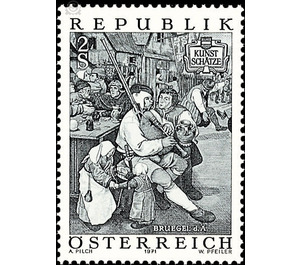art treasures - Austria / II. Republic of Austria 1971 - 2 Shilling
Theme: Art & Culture
| Country | Austria / II. Republic of Austria |
| Issue Date | 1971 |
| Face Value | 2.00 |
| Color | green |
| Printing Type | Typography |
| Stamp Type | Commemorative |
| Item Type | Stamp |
| Chronological Issue Number | 704 |
| Chronological Chapter | OOS-OE2 |
| SID | 846254 |
| In 58 Wishlists | |
In the 17th century, Emperor Leopold I united the courtly collections from the Netherlands, Prague and Vienna. Later came the works from the Spanish Netherlands, which included, for example, the Rosary Madonna of Caravaggio. It was not until the 20th century that the collection was expanded to complete the missing or poorly represented painting schools. In 1967, a collection of paintings of the international 19th century was founded and set up as a "New Gallery" in the Stallburg. The stamp motif shows a part of the picture "Bauerntanz" by Pieter Breughel the Elder (born between 1525 and 1530, died 1569). With this work Breughel created a whole new genre: For the first time, the farmer and his work were artistically immortalized. Throughout his life, Breughel felt attached to peasant life, and so the farmer - hitherto seen as a tolerated working object at best - became a hero at the "Bauerntanz".


